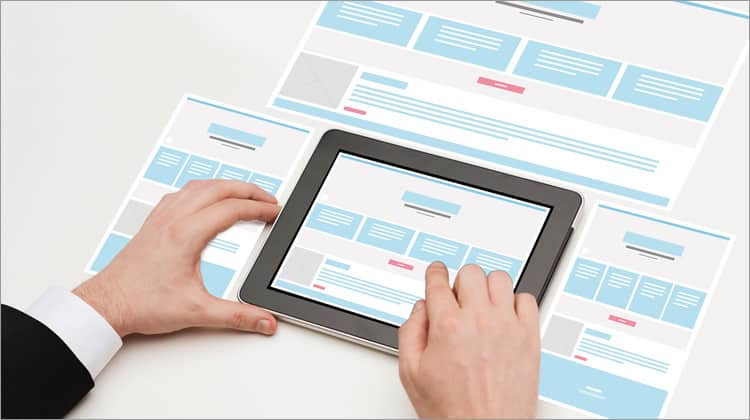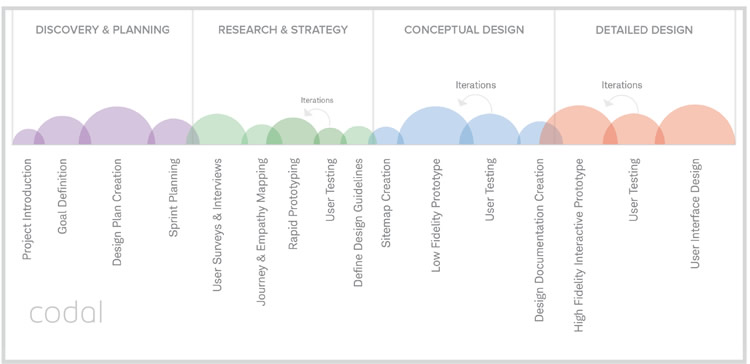
A UX design process is something that everyone has in the UX industry, but something that everyone does differently. While the majority may maintain the same flow and general process, it is the principles that are executed within the process that are done so differently.
When it comes to the user experience design process, one size may not fit all. As a designer, or a UX agency, I am sure you have been asked many times “what is your UX design process?” While you can certainly give a high-level overview, you should not have a defined process until you learn the project details.
The Importance of a UX Design Process
A clear and concise user experience process can sometimes define the quality of the end product. It can easily be the make-it or break-it aspect. Without a solid UX design process, a designer could be completely shooting in the dark during this phase of a project. Some even argue that without a process, you are more of an idealist than a designer.
Although this process is so important, there really is not just one process that can be used on every project that you work on. Relying on the same process for every website or application, chances are you will end up with a confused client or an angry manager.
The Importance of a Dynamic Process
The below chart is a high-level overview of the UX design process that the company where I work, Codal uses.

While we take our clients through this entire process, we ensure that it is well-known that the tasks within each phase will likely change once we get into the discovery and planning phase.
Having a dynamic process, broken down into a few different larger stages is important to keep consistent from project to project. It is the practices within each phase that should be catered to each project.
While our main stages of the UX design process are broken down into: discovery + planning -> research and strategy -> conceptual design -> detailed design, other agencies and designers may opt to break it down differently. The following are some examples of different UX design workflows:
Requirements -> sketches -> wireframes -> mockups -> implementation
Strategy -> research -> analysis -> design -> production
Research -> prototype -> test -> visual design
This is something that is less impactful than what goes into each stage. For example, some of the UX offerings at Codal include: ethnographic research, focus groups, usability testing, dogo mapping, and high-fidelity wireframes. However, not every client has the time and budget for the above items. Conversely, some of these services may not be necessary for every website or app being designed.
Why isn’t there just One UX Design Process?
While some processes may be repeatable, in most cases they will not be. Using the same process over and over again does not guarantee success. A user experience process should be tailored to fit specific project needs, both business and functional. While there are some practices you obviously have to follow (research before wireframes), there are principles within every part of the process that have to be custom designed for the specific project.
As a designer, it is likely that all of your clients do not have a million dollar budget with an endless time frame. Things like budget, time, resources, and technology are some constraints that may not allow a UXD to do everything that they desire.
For example, a website that has been up and running for 8 years has a considerable amount of data and analytics that can be analyzed and used to make an informed decision. It also probably has a number of real users that have interacted with it and who are ready to give authentic feedback through interviews, surveys, or focus groups.
Still, if for your next project you opted to rely once again on interviews, surveys or focus groups for your research phase, where would you begin if this project consists of a startup app, that has zero user data?
Yes, you can still survey “potential users” that are the target market of the product, but the context is still different, and contrasting details would have to be taken into consideration. Therefore, even if surveys are given out for both scenarios, the practices of your analysis would have to change slightly.
While our designers would love to do user interviews and surveys for each and every app they strategize, sometimes it simply is not possible because of the restraints and project requirements. This means that another tool must be utilized instead – one that enables talking to real users.
Instead of conducting a series of interviews, a designer could always look at secondary research. While it may not be the most effective as coordinating your own research, you may not have much of a choice due to project restraints. Secondary research can actually be a very cost-effective solution if budget is an issue.
Keeping Profitability in Mind
As a user experience designer, it can be easy to get carried away with best UX practices, principles and tasks. It is your goal for the user to have the best possible experience on the platform that you design, and it is understandable that you want to do everything you can to ensure that positive experience.
When an individual is in school for user experience design, or human-computer interaction, they are taught the process that will ensure a successful end product.
In the real world, there are roadblocks, budget restraints and chances are that you may be working with a client who may not see the value in the user experience process.
It can be difficult to stay within the scope of work when you do not think you have enough hours to achieve your goal, but it is your duty to stay within that scope. If not, your agency may not be making a profit on the project. You must keep profitability in mind for yourself and for your employer.
Conclusion: UX Designers Should be Flexible with every Project
The most successful UX design processes are both versatile and adaptable.
If there are restraints, the designer needs to be able to adjust to the situation. Prior to starting a UX project, it is key for any UX team to analyze all that should be done to accomplish their goals, all while considering the best interests of the agency and client.
Designing a startup website for the nightlife industry, versus an enterprise application for a large financial firm, versus a children’s iPad app for a school district, all require a different process, different tasks, and a different attitude.
To ensure success, you should always assess the value that each task has for that specific project. Happy project planning!
Want to learn more?
If you’d like to become an expert in UX Design, Design Thinking, UI Design, or another related design topic, then consider to take an online UX course from the Interaction Design Foundation. For example, Design Thinking, Become a UX Designer from Scratch, Conducting Usability Testing or User Research – Methods and Best Practices. Good luck on your learning journey!
(Lead image: Depositphotos)
